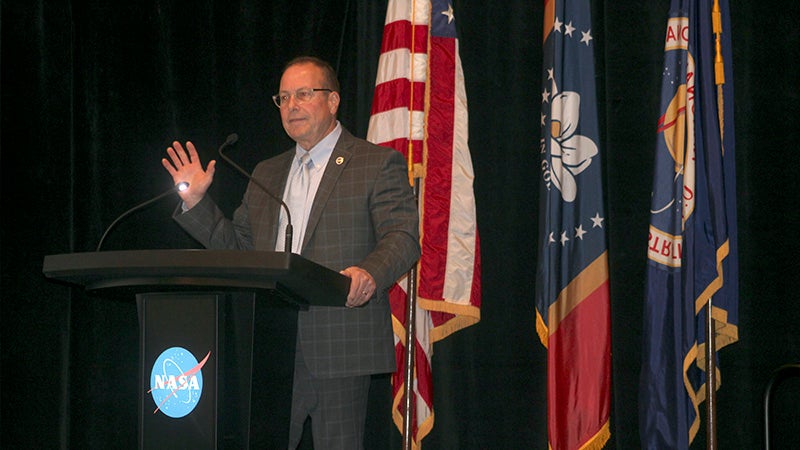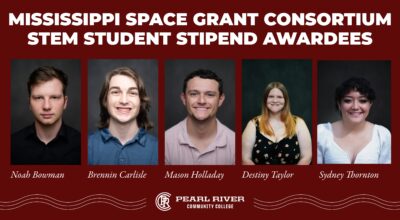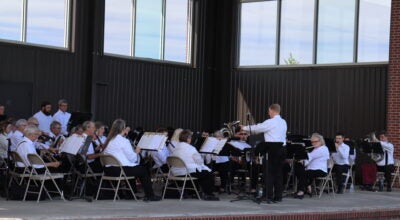State of Stennis shared during breakfast
Published 1:47 pm Saturday, May 7, 2022

- Director for NASA Stennis Space Center Richard Gilbrech gives an overview about the Center at the Director’s Community Briefing Breakfast. Photo by David Thornton Jr.
Wednesday morning, Stennis Space Center held a Directors Community Briefing Breakfast hosted by the Partners for Stennis and Michoud. Every year this event is held to present a briefing with partnering organizations that operate at the rocket testing facility.
In attendance were Chairman of Michoud Mark Glorioso, Center Director for NASA Stennis Space Center Richard Gilbrech, Director of NASA Michoud Assembly Facility Lonnie Dutreix, Naval Meteorology & Oceanography Command Commander Ron Piret, Director of National Data Buoy Center William Burnett, Staff Propulsion Test for Relativity Space Engineer Andy Guymon, and Executive Director of Infinity Space Center Michelle Anderson.
During the presentation attendees heard that 84 percent of Stennis Space Center’s work force is vaccinated. Stennis is also transitioning to stage 1 of NASA’s framework for returning to onsite work. All directories and offices will transition to a hybrid work environment. In 2021, Stennis had an economic impact of $1.2 million and $165 million is total state and federal contributions. Stennis has over 5,000 employees.
Michoud’s overview stated it remaines the world’s largest facility with 2.2 million square feet. The facility is operating at stage 1 with up to 75 percent occupancy. Michoud’s facility was hit by Hurricane Ida on August 29 2021. The facility recorded 150 mph of winds and 13 inches of rain during the storm. Due to water intrusion and roof damage, Michoud received a MAF Supplement grant in the amount of $241.8 million for repairs.
Admiral Ron Piret has been in the Navy for 30 years, and for the past year he’s taken on the responsibility of Commander at Naval Meteorology and Oceanography Command.
They help guide ships, aircraft and troops with recommendations based on weather forecasts and ocean conditions. They also relay forecast updates and weather warnings to military and civilian authorities. Their job is to better understand the ocean and predict what’s going on.
“We are involved in every aspect of Naval warfare and the Navy’s overall mission. There’s not a submarine ship that goes to sea or an aircraft that flies that we’re not involved, not only in their safety in navigation in flight, but also ensuring we maximize the fleet’s vitalit. We really have a broad spectrum of professionals,” said Piret.
Piret said the work at his facility requires talent in engineering, physics, computer science, and geology.
“We take all that talent… in collecting observations, 100 million observations a day, and turn that data, not only into platform and sensor performance, but then how do we predict the future battle space environment so that we can better understand where the advantages are, in safety and ensuring the nation’s interest and maintain freedom of navigation,” said Piret.
Michelle Anderson has been Executive Director of the Infinity Science Center for two years. Infinity Space Center exists to build people.
“We build people, ultimately that’s what we do. Building our next generation of mathematicians, scientist engineers, that’s what we do,” said Anderson.
Young people are the center’s bread and butter, but adults are welcome. Anderson said most people think the Infinity Space Center is a play place or for “kiddos,” but she said the parents find themselves having more fun than the kids.
“We’re reaching any age, anybody who cares about STEM at all,” said Anderson.
In May of 2021 the Infinity Space Center re-opened to the public following the COVID-19 pandemic. Anderson said they had 400 plus people come when it reopened, nearly double the pre-pandemic average.
“It was our most notable (event) to do with half the staff, half the resources, having been over worked at the time but able to do it, have fun and make our presents feel that we’re back on again,” said Anderson.
The Infinity Space Center has been booming since it re-opened to a point of several events are over capacity. In a attempt to not turn attendees away, Anderson and her staff customize the plan to fit them in.





